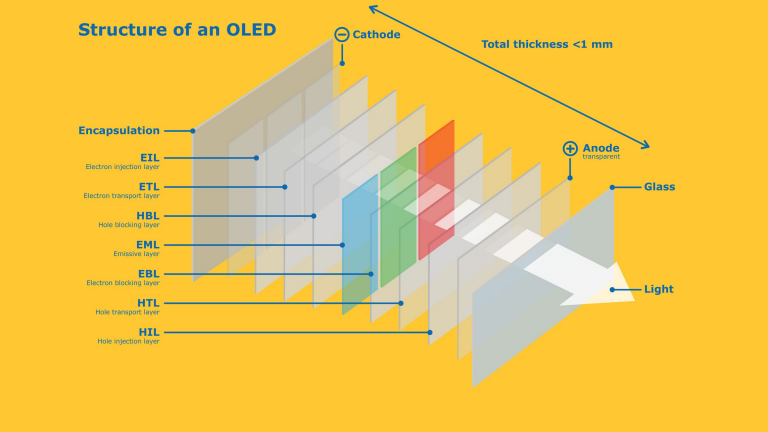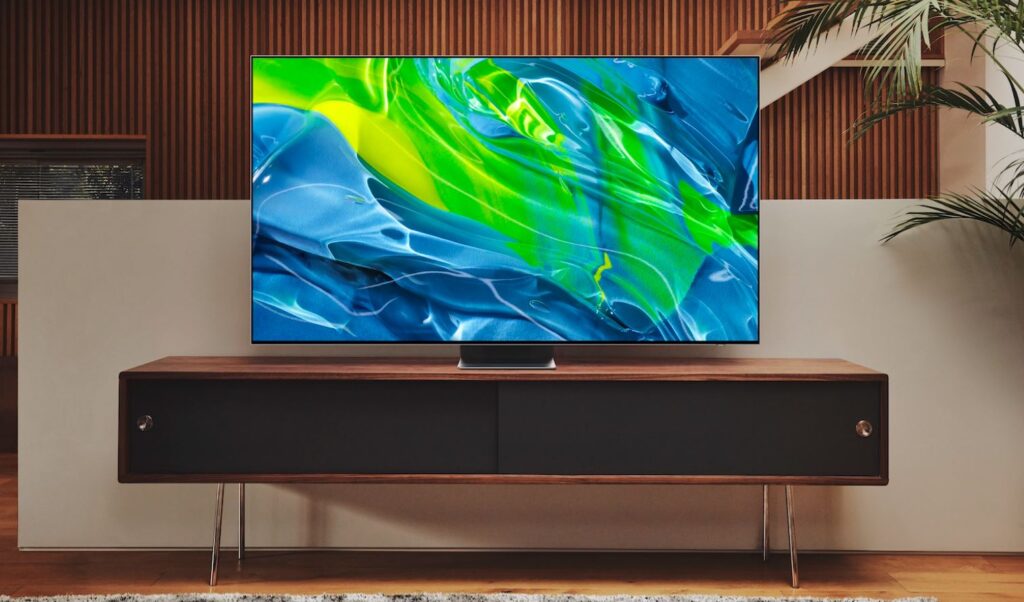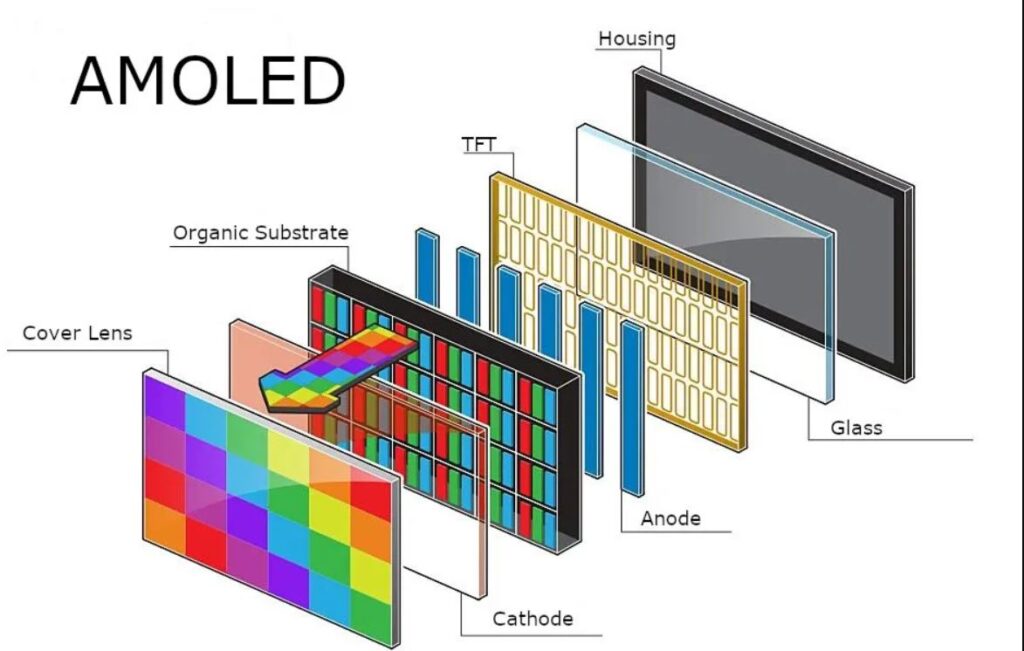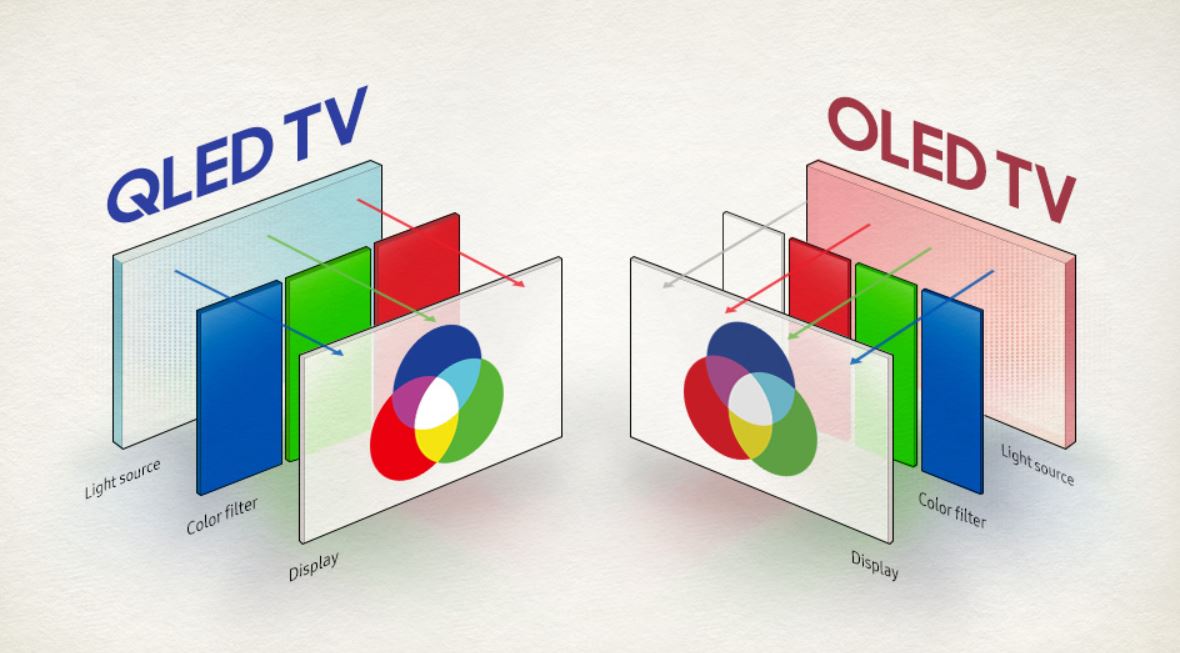When looking at the latest laptops, greatest computer monitors, TVs, or even phones, you’ve most certainly seen a variety of display types. LCD, IPS, and LED displays are relatively out of date, whereas OLED is currently the most premium and sought-after panel type. However, you will occasionally hear the terms QD-OLED, QLED, AMOLED amoled display, and Mini LED. This may make you question what the difference is between OLED, QD-OLED, QLED, AMOLED, and Mini LED, and which is preferable.
The specific design and production methods for each display type are all quite sophisticated. But do not worry. I’m here to explain the differences and what they imply to you. I’ll also discuss which display kinds are best in different settings.
DIFFERENCE BETWEEN OLED, QD-OLED, QLED, AMOLED, AND MINI LED?
There are significant differences between how OLED, QD-OLED, QLED, AMOLED, and Mini LED displays are created. These variances result in some significant differences in the viewing experience. Let’s start by talking about how each one is manufactured and what it means for you.
OLED Display
The abbreviation ‘OLED’ refers for Organic Light-Emitting Diode, which is a technology that employs LEDs to produce light from organic molecules. These organic LEDs are utilized to generate what are regarded as the world’s best display screens.
OLED materials are utilized to create thin sheets sandwiched between two conductors. When an electric current is applied, a bright light is produced. A basic design offers numerous advantages over other display technologies.

OLEDs enable emissive displays, which implies that each pixel is separately controlled and generates its own light (unlike LCDs, which get their light from a backlighting unit). OLED displays have excellent image quality, with vibrant colors, quick motion, and, most significantly, extremely high contrast. Most notably, “real” blacks (which are not possible in LCDs due to illumination). The simple OLED design also makes it relatively straightforward to manufacture flexible and transparent displays.
Structure Of OLED Display

The fundamental OLED structure is simple: an organic emitter sandwiched between two electrodes. However, in order to produce effective and long-lasting devices, commercial OLEDs employ multiple intermediate layers, such as electron transport and blocking layers. The entire organic stack is sandwiched between the electrodes and printed on the substrate (glass or plastic) and display backplane (driver electronics). Some OLED displays on the market use dozens of distinct layers stacked on top of each other.
QD-OLED Display
A QD-OLED, or quantum dot organic light-emitting diode, is a step above the basic OLED display and is relatively new to the market, having been invented by Sony in 2021. As previously stated, OLEDs provide excellent color accuracy and contrast due to their ability to produce genuine black. Meanwhile, a QD-OLED is essentially an OLED display that uses quantum dots (microscopic molecules that emit a distinct color when light strikes them from a backlight) to increase brightness levels beyond what OLEDs can accomplish.
So, from the user’s perspective, QD-OLEDs still provide excellent color and contrast, but they may display imagery better in brightly light locations than OLEDs since their panels can be brighter.
QD-OLEDs are known to acquire screen burn-in more quickly than the other display types discussed here. It is worth mentioning that there hasn’t been much testing with QD-OLEDs, thus certain facts may change as the world learns more about these displays.

The greatest QLED TVs feature vibrant colors and brightness that leaps off the screen. However, it is similarly difficult to duplicate the extreme dark levels, ultra-rich colors, and tremendous contrast of an OLED display.
Also Read About: Exploring 19 Secret Features of the Samsung galaxy s24 ultra and Game-Changing Upgrades
Structure Of QD-OLED Display

QD-OLED is a self-emitting display technology, similar to Samsung’s Super AMOLED screens seen in Galaxy smartphones, tablets, and wearables. Each pixel in this display screen can generate its own illumination and color. It performs differently than LG’s WRGB OLED and Samsung’s Super AMOLED displays. It utilizes millions of extremely small quantum dots to boost total color volume and average brightness.
A QD-OLED display uses a blue OLED layer as a backlight source, which is an excellent invention from Samsung Display. The OLED layer is constructed of organic materials (thus the O in OLED), and the light emitted from it is routed via quantum dot color filters (also known as quantum dot color converters) to produce red and green colors. Because the backlight is blue, it does not require a color converter to achieve that color, and it is passed as it is.
QLED Display
QLED is the least stunning and least expensive display type I’ll cover, but it’s also one of the most recent, introduced by Sony in 2013. Despite the name, these are not OLEDs. They’re essentially LCD screens that use quantum dots, which are small molecules that emit a different color when exposed to light from a backlight.
QLEDs are less expensive to manufacture than other display types, hence they are frequently employed in the production of lower-cost televisions. However, their image quality is not as consistent as OLED, WD-OLED, AMOLED, or Mini LED. Furthermore, they do not deliver the same level of color fidelity or true blacks as other display types.

It’s worth noting that Samsung has created certain QLED TVs with Mini LED illumination rather than traditional LED backlighting. These cost more, are more reliable, and are regarded as premium QLEDs.
Structure Of QLED Display

In QLED TVs, a layer of nanocrystals is put above LED lights, and because each nanocrystal quantum dot produces its own light, the colors produced are brighter and more precise.
Quantum Dots can thus provide high brightness, whilst OLED produces the deepest blacks. When the two come together, QLED is produced, giving you the best of both worlds.
QLED replaces the photoluminescent quantum dots used in conventional Quantum Dot TVs with electroluminescent quantum dots, allowing light to be supplied directly to the display. This eliminates the need for an LED backlight, resulting in no color distortion. When no hues are distorted, black is pure, resulting in a good contrast ratio when watched.
Simply put, a QLED TV does not require a separate backlight for illumination. It naturally controls light in individual pixels, ensuring that blacks are not distorted and are deep, resulting in a good contrast ratio.
AMOLED Display
An AMOLED, or active-matrix light-emitting diode, is a newer type of display that was invented in 2006. They are essentially OLED displays that use the aforementioned active matrix (a technique in which each pixel is controlled individually rather than as a group). AMOLED displays are greater quality than OLED displays because they are much more flexible and use backplane technology (physical connection points that allow electronics to communicate between slots), as well as a layer of thin-film transistors (TFTs), which OLEDs do not have. However, they do not produce a true black like OLED displays do.
To clarify, TFTs are commonly associated with liquid crystal displays (LCDs), however this film is also used in AMOLED to help control the electrical flow of the display.

OLEDs excelled conventional LEDs by creating light by applying current to a different type of semi-conductive material — organic compounds that work at such a small scale that they allow pixel-by-pixel illumination and color control. A display’s pixels can be adjusted brighter or darker (or completely “black” if no power is applied). Without an intervening LCD panel, this results in extremely fine light and color control, as well as extreme contrast ratios. [Depending on the manufacturer, the color of each pixel you see is produced either by beaming single-color OLED light through an RGB filter (like in conventional LED-LCD models) or by employing different organic chemicals that produce distinct wavelengths.
Structure Of AMOLED Display

Amoled displays are active matrix organic light-emitting diodes. Throughout the development process, AMOLED panels have evolved into numerous varieties, including AMOLED, SuperAMOLED, SuperAMOLEDPlus, SuperAMOLEDAdvanced, and others.
The AMOLED screen consists of three layers: the AMOLED screen, the TouchScreenPanel (touch screen panel), and the exterior protective glass. AMOLED is a type of OLED technology that depicts a self-luminous display by utilizing many layers of organic compounds to produce independent R, G, and B three-color light.
AMOLED does not have a striped anode or cathode. The anode and cathode are complete layers. The extra layer of thin-film transistor array between the cathode and the screen is what distinguishes it, however. This layer of TFTA affects whether the pixel above is bright or not. Because TFTA consumes less energy than PMOLED’s external circuit and has a faster color-changing reaction.
Mini LED Display
The Mini LED (or mini-LED) display (not to be confused with micro-LED) was invented in 2000 and works differently than earlier panel types because it uses backlighting by putting tens of thousands of microscopic LED lights below an LCD substrate (the glass used in TFT LCDs). The use of microscopic LEDs rather than standard-sized ones seen in other LCD displays provides for greater control in terms of displaying suitable hues and precise brightness or darkness levels inside specified regions of a picture.

Mini LEDs, like OLEDs, do a considerably better job of depicting true black than AMOLEDs, although they aren’t as accurate in terms of color. However, their architecture allows for a slimmer, more power-efficient structure.
OLED vs QD-OLED vs QLED vs AMOLED
Here are some points that differentiate between all of the displays and factors that will help you to choose the best display according to your requirements.
| Feature | OLED | QD-OLED | QLED | AMOLED | Mini LED |
|---|---|---|---|---|---|
| Display Technology | Organic Light Emitting Diodes | Quantum Dot Organic Light Emitting Diodes | Quantum Dot Light Emitting Diodes | Active Matrix Organic Light Emitting Diodes | Light Emitting Diodes with Miniaturized Size |
| Light Source | Each pixel emits its own light | Each pixel emits its own light | Backlit by LEDs | Each pixel emits its own light | Backlit by an array of Mini LEDs |
| Contrast Ratio | Infinite (Perfect blacks) | Infinite (Perfect blacks) | High | Infinite (Perfect blacks) | High |
| Color Accuracy | Excellent | Excellent | Excellent | Excellent | Excellent |
| Viewing Angles | Wide | Wide | Good | Wide | Wide |
| Brightness | Bright | Bright | Very Bright | Bright | Very Bright |
| Thickness | Ultra-thin | Ultra-thin | Slim | Flexible and Slim | Slim |
| Response Time | Fast | Fast | Fast | Fast | Fast |
| Lifespan | Limited by organic materials | Limited by organic materials | Long | Limited by organic materials | Long |
| Burn-in Risk | Potential risk | Potential risk | No risk | Potential risk | No risk |
| Cost | Expensive | Expensive | Varies | Varies | Varies |
| HDR Performance | Excellent | Excellent | Very Good | Excellent | Very Good |
Conclusion
The Battle of the Screens demonstrates the energy and creativity of the technology industry. Whether it’s OLED’s self-emissive pixels, QLED’s quantum dot upgrades, or hybrid technologies like QD-OLED, each has carved itself its own market niche. The final decision is ultimately determined by the user’s priorities, whether it be the pursuit of dramatic images, gaming excellence, or the needs of a portable device. The continuing rivalry means that display technology will continue to advance, promising even more astonishing visual experiences for consumers in the years ahead.
Continue Reading……..


